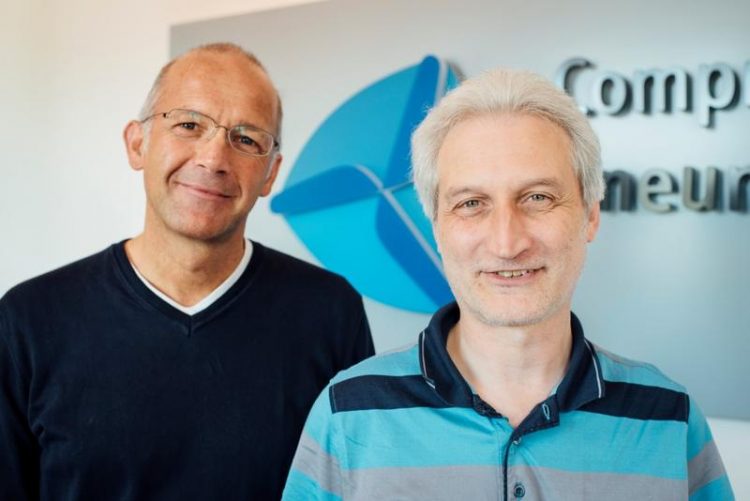Lung Research – EU Horizon 2020 funding to predict nanotoxicity

Dr. Tobias Stöger and Dr. Otmar Schmid Source: Helmholtz Zentrum München
Nanoparticles are extremely small particles that can penetrate into remote parts of the body. While researchers are investigating various strategies for harvesting the potential of nanoparticles for medical applications, they could also pose inherent health risks*. Currently the hazard assessment of nanomaterials necessitates a complex and laborious procedure. In addition to complete material characterization, controlled exposure studies are needed for each nanomaterial in order to guarantee the toxicological safety.
As a part of the EU SmartNanoTox project, which has now been funded with a total of eight million euros, eleven European research partners, including the Helmholtz Zentrum München, want to develop a new concept for the toxicological assessment of nanomaterials.
Reference database for hazardous substances
Biologist Tobias Stöger and physicist Otmar Schmid, both research group heads at the Institute of Lung Biology and Disease, hope that the use of modern methods will help to advance the assessment procedure. “We hope to make more reliable nanotoxicity predictions by using modern approaches involving systems biology, computer modelling, and appropriate statistical methods,” states Stöger.
The lung experts are concentrating primarily on the respiratory tract. The approach involves defining a representative selection of toxic nanomaterials and conducting an in-depth examination of their structure and the various molecular modes of action that lead to their toxicity. These data are then digitalized and transferred to a reference database for new nanomaterials. Economical tests that are easy to conduct should then make it possible to assess the toxicological potential of these new nanomaterials by comparing the test results s with what is already known from the database. “This should make it possible to predict whether or not a newly developed nanomaterial poses a health risk,” Otmar Schmid says.
Further information:
* Review: Schmid, O. and Stoeger, T. (2016). Surface area is the biologically most effective dose metric for acute nanoparticle toxicity in the lung. Journal of Aerosol Science, DOI:10.1016/j.jaerosci.2015.12.006
http://www.sciencedirect.com/science/article/pii/S0021850215301166
The project is coordinated by Dr. Vladimir Lobaskin from University College Dublin. For more information and a list of all partners visit http://cordis.europa.eu/project/rcn/200824_en.html
As German Research Center for Environmental Health, Helmholtz Zentrum München pursues the goal of developing personalized medical approaches for the prevention and therapy of major common diseases such as diabetes mellitus and lung diseases. To achieve this, it investigates the interaction of genetics, environmental factors and lifestyle. The Helmholtz Zentrum München has about 2,300 staff members and is headquartered in Neuherberg in the north of Munich. Helmholtz Zentrum München is a member of the Helmholtz Association, a community of 18 scientific-technical and medical-biological research centers with a total of about 37,000 staff members. http://www.helmholtz-muenchen.de/en/index.html
The Comprehensive Pneumology Center (CPC) is a joint research project of the Helmholtz Zentrum München, the Ludwig-Maximilians-Universität with its University Hospital and the Asklepios Fachkliniken München-Gauting. The CPC's objective is to conduct research on chronic lung diseases in order to develop new diagnosis and therapy strategies. The CPC maintains a focus on experimental pneumology with the investigation of cellular, molecular and immunological mechanisms involved in lung diseases. The CPC is one of five sites of the German Center for Lung Research (Deutsches Zentrum für Lungenforschung, DZL). http://www.helmholtz-muenchen.de/en/ilbd/index.html
The German Center for Lung Research (DZL) pools German expertise in the field of pulmonology research and clinical pulmonology. The association’s head office is in Giessen. The aim of the DZL is to find answers to open questions in research into lung diseases by adopting an innovative, integrated approach and thus to make a sizeable contribution to improving the prevention, diagnosis and individualized treatment of lung disease and to ensure optimum patient care. http://www.dzl.de/index.php/en
Contact for the media:
Department of Communication, Helmholtz Zentrum München – German Research Center for Environmental Health (GmbH), Ingolstädter Landstr. 1, 85764 Neuherberg – Phone: +49 89 3187 2238 – Fax: +49 89 3187 3324 – E-mail: presse@helmholtz-muenchen.de
Scientific contact at Helmholtz Zentrum München:
Dr. Tobias Stöger, Helmholtz Zentrum München – German Research Center for Environmental Health (GmbH), Comprehensive Pneumology Center Ingolstädter Landstraße 1, 85764 Neuherberg- Tel. +49 89 3187 3104 – E-mail: tobias.stoeger@helmholtz-muenchen.de
Dr. Otmar Schmid, Helmholtz Zentrum München – German Research Center for Environmental Health (GmbH), Comprehensive Pneumology Center, Ingolstädter Landstraße 1, 85764 Neuherberg- Tel. +49 89 3187 2557 – E-mail: otmar.schmid@helmholtz-muenchen.de
Media Contact
All latest news from the category: Awards Funding
Newest articles

Properties of new materials for microchips
… can now be measured well. Reseachers of Delft University of Technology demonstrated measuring performance properties of ultrathin silicon membranes. Making ever smaller and more powerful chips requires new ultrathin…

Floating solar’s potential
… to support sustainable development by addressing climate, water, and energy goals holistically. A new study published this week in Nature Energy raises the potential for floating solar photovoltaics (FPV)…

Skyrmions move at record speeds
… a step towards the computing of the future. An international research team led by scientists from the CNRS1 has discovered that the magnetic nanobubbles2 known as skyrmions can be…





















